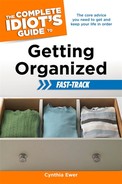Creating Activity Centers for an Organized Home
Like our souls, our surroundings need a center. Spaces support us best when they are organized around the activities we’ll be doing in them, not according to label or location. To achieve this level of support, implement the concept of activity centers—dedicated places to carry out household functions.
For a model, look no further than a good preschool. Scan the room, and you’ll see spaces allocated to every school-day pursuit. There’s a dress-up corner, a sand table, and a gathering carpet for group activities like storybook reading. Each young pupil knows where to go to play, rest, or read. At day’s end, little learners know where to go to put away blocks, toys, or dress-up costumes.
Putting the same concept to work in your home speeds life on every level. A well-stocked home office activity center means never having to leave the room to hunt for postage stamps. A gift-wrap station keeps everything you need to wrap and mail a birthday gift close at hand.
In the kitchen, centers work together to create an organized environment for cooking. Near the sink, you’ll find a sink center, with strainers, cutting boards, peelers, and knives—everything you’ll need to scrub and chop the evening vegetables. On the counter, an activity center focused on the oven contains measuring cups, an electric mixer, flour, and baking soda—everything you need to whip up a batch of muffins on a rainy day. At the stovetop, saucepans nest on nearby shelves, while spatulas, wooden spoons, and wire whisks stand ready to beat, fold, or blend.
Essentials of an Activity Center
To put the activity center concept to work, start by identifying the activity and making a list. Working room by room, list each activity that you carry out in the area. For example, a bedroom might have the following list:
• Sleeping
• Storing clothing
• Getting dressed
• Reading and watching television
For each activity, determine what you need to create a supportive center. Even if their locations overlap, each activity center will involve a different constellation of tools, materials, and supplies. The sleep center needs a night table, alarm clock, and bedside lamp; to watch television, you’ll make use of the same night table and lamp, but add a remote control and a pair of eyeglasses for easy viewing.
Finally, assess the available storage options for each center. Place the most-used tools in the most accessible space, consigning things for occasional use to storage spaces where you have to stretch, bend, or reach. In the bedroom centers, extra blankets and a flashlight for emergencies find a home in an under-bed storage container, while used-daily items like the alarm clock and reading glasses take their place on the nightstand.
Get creative when establishing centers—efficient storage isn’t limited to drawers and closets. Nondamaging adhesives anchor a small bin to hold the remote control on the wall next to the bed, or affix a hook to hang night clothes in the closet. An open basket next to the night table corrals books, reading glasses, and the television schedule. Think outside the dresser drawer to make your spaces work for you.
The Household Launch Pad
While any family’s activity centers will be as individual as they are, most of us will want to create a household launch pad. Just as the space shuttle needs a structure to support it at liftoff, so do family members. A household launch pad is a dedicated place to manage the business of getting out the door each day.
A household launch pad is home to briefcases and diaper bags, backpacks and purses, and should be located near the entry door. Ensure that the location offers sufficient space for each household member to have a separate launch pad.
A dedicated section of counter space, low bookcases, or entryway tables are workable options for launch pad duty. Commercial solutions include specialized shelf units with hooks, low shelves, and multiple bins. Color-coded bins lined up on a shelf make a good choice for small children; add a charging station for electronic devices carried by teens and adults.
The household launch pad is home to all the stuff each family member needs to get out the door. For adults, it’s the place where purses and briefcases land; for children, the launch pad corrals homework, library books, and lunchboxes. Parents can check the launch pad each day to find homework assignments and permission slips.
Head straight to the launch pad each afternoon to drop off paperwork, schoolbooks, lunch sacks, and ID badges. In the evening, check in at the launch pad to sign permission slips, wash out lunch containers, and complete the next day’s paperwork. In the morning, the launch pad will blast the family forward again, fully supplied with the needs of the day.
